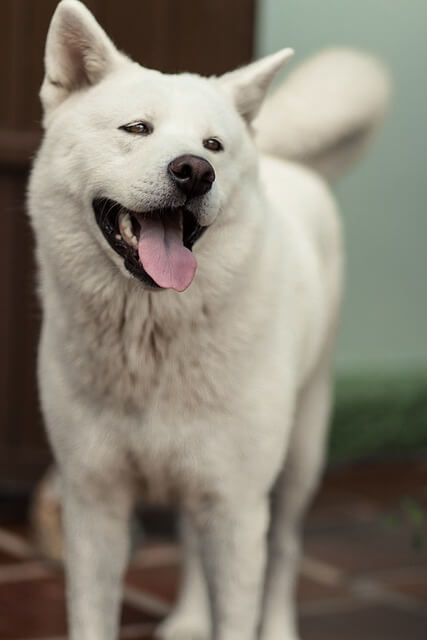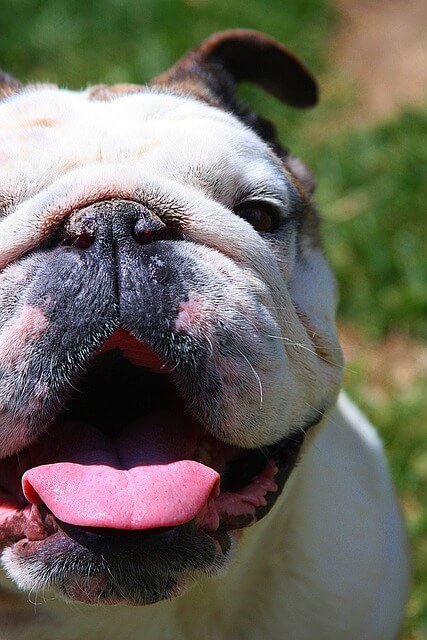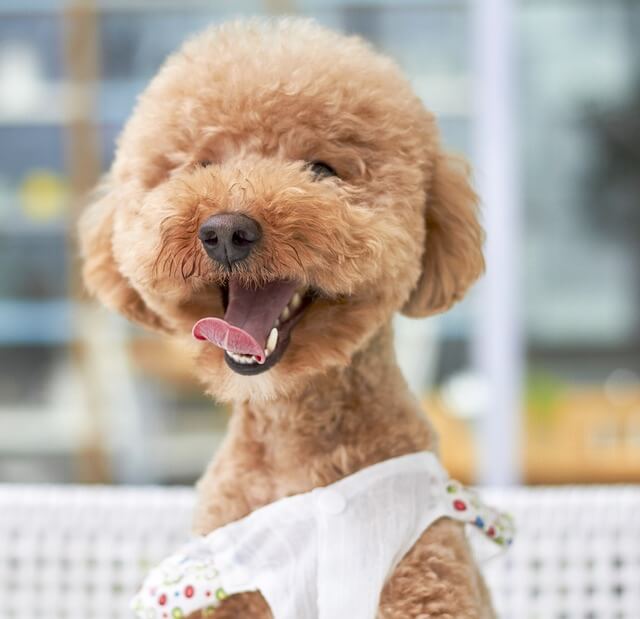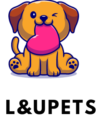
Intro
In the intricate dance of communication between dogs and their human companions, few gestures are as endearing or as mystifying as the dog side eye smile.
This subtle, yet expressive, facial movement often leaves dog owners puzzled, wondering what their furry friend is trying to convey.
Is it a sign of happiness, mischief, or something else entirely?
Understanding the nuances of this canine expression can significantly enhance the bond between you and your dog, leading to a deeper, more empathetic relationship.
Unpacking the Dog Side Eye Smile: More Than Just a Look

The dog side eye smile, often perceived as a mere facial expression, is a rich tapestry of canine communication, weaving together elements of trust, comfort, and shared connection.
This particular gesture—where a dog averts its head slightly, maintaining you within its peripheral vision while displaying a relaxed, open-mouthed grin—embodies a complex communication form. Far from a straightforward action, it represents a nuanced interaction strategy in the canine world. Contrasting the potential confrontation of direct eye contact, this sidelong glance conveys a message softened by subtlety, a deliberate choice by the dog to engage without the intensity that a head-on look might imply.
This gesture’s intricacies are rooted in the dog’s instinctive language, reflecting a blend of their current emotional state and their desire to connect with their human companion in a non-threatening manner. The side eye smile often surfaces in moments of relaxed contentment or gentle playfulness, serving as a bridge of understanding and mutual respect between species. It’s a testament to the dog’s sensitivity to social dynamics, showcasing their ability to adapt their communication to foster a positive and reassuring atmosphere for their human counterparts.
This form of expression also highlights the evolutionary journey of dogs as companions to humans, pointing to their remarkable ability to “speak” in a way that is both understood and appreciated by those who care for them.
It underscores the importance of reciprocal communication in strengthening the bond between dog and owner, offering a window into the dog’s emotions and thoughts through a simple, yet profound, smile. Understanding this gesture requires observers to tune into the subtleties of canine communication, recognizing the side eye smile as a meaningful element in the broader context of their relationship with their dog.
The Science Behind the Smile: Can Dogs Truly Smile?
The concept of a smiling dog has long intrigued both pet owners and scientists alike, sparking debate over the capabilities and emotions of our canine friends. Unlike humans, who smile as a universal sign of happiness, dogs may not share the same physiological motivations for smiling. However, recent scientific explorations suggest that dogs have developed facial expressions, including what appears to be a smile, as a means of communication with humans. The phenomenon known as the “dog side eye smile” could very well be part of this communicative repertoire, aimed at fostering positive interactions with their owners.
Research indicates that dogs are astute observers of human behavior and can adapt their actions to engage more effectively with us.
This adaptability includes using facial expressions that prompt a favorable response from their human companions. A dog’s side eye smile, therefore,
might not stem from an inner feeling of joy akin to human happiness but could be a strategic behavioral expression cultivated through centuries of domestication and interaction with humans. It is thought to signal a variety of intentions or feelings, such as a desire to play, express affection, or even a form of appeasement.
Further scientific investigation into canine behavior and brain activity reveals that dogs do experience emotions that could be related to the expressions we interpret as smiles.
While the emotional lives of dogs are not identical to humans, the capacity for dogs to feel pleasure, excitement, and attachment is evident.
Thus, when a dog gives a side eye smile, it might indeed be expressing a positive emotional state, albeit through a lens shaped by evolution and the unique dynamics of human-dog relationships.
Deciphering the Context: When Do Dogs Display This Gesture?

The moments when a dog chooses to showcase the side eye smile can vary greatly, each offering a window into their current emotional landscape.
This expression might make an appearance during lighthearted play, signaling a relaxed and joyful mood, inviting you to join in the fun. It’s a gesture that could also greet you as you return home, serving as a warm welcome after a period of separation, reflecting your dog’s relief and happiness at your reunion.
In contrast, this expression may surface in more nuanced situations, such as after a moment of mischief or when your dog senses they might have displeased you. Here, the side eye smile acts as an olive branch, an attempt to smooth over any potential discord with a look that seems to say, “Can we still be friends?” It’s a testament to their social intelligence, demonstrating an awareness of the complex emotional dynamics at play.
Observing the context and accompanying body language is key to interpreting this gesture accurately. A wagging tail, relaxed posture, and playful bounces might accompany the side eye smile during moments of joy, whereas a lowered head or a hesitant approach might signal a more appeasing or conciliatory intent.
Each instance of the side eye smile weaves into the fabric of your shared experiences, offering insights into your dog’s feelings and perspectives. Recognizing and understanding these moments enhances the dialogue between you, enriching the bond you share with your canine companion.
How Should You Respond to Your Dog’s Side Eye Smile?
When faced with your dog’s side eye smile, the manner in which you react can play a crucial role in nurturing your bond and ensuring your furry companion feels understood and valued. This gesture, often an amalgam of joy, playfulness, or a gentle plea for reassurance, requires a nuanced response that mirrors the complexity of its meaning. If the side eye smile emerges during moments of play or joy, engaging in the moment with laughter, returning a warm smile, or initiating a game can serve as a powerful affirmation of their behavior. This reaction not only rewards their attempt at communication but also strengthens the joyous connection you share.
Alternatively, if the side eye smile appears in situations where your dog might be seeking forgiveness or attempting to alleviate tension, your response should pivot towards offering comfort and reassurance.
A gentle pat, soft spoken words, or a calm demeanor can communicate to your dog that all is well, reinforcing a safe and trusting environment.
This approach acknowledges their gesture of appeasement and reassures them of your unwavering support and love, critical in maintaining their emotional well-being.
Engaging with your dog’s side eye smile through these tailored responses not only validates their efforts in communicating with you but also deepens the mutual understanding and respect foundational to your relationship.
It is through these thoughtful exchanges that the bond with your dog flourishes, underpinned by a shared language of empathy and emotional connection.
Beyond the Smile: Other Key Canine Body Language Signals to Watch

Understanding your dog’s side eye smile is just the beginning of decoding their complex system of communication. Dogs use their entire body to express a variety of emotions and intentions, making it crucial for dog owners to be observant of other key signals.
For instance, a wagging tail often indicates happiness, but the speed and height of the wag can also suggest levels of excitement or even slight agitation.
Ears play a significant role as well; perked ears might mean your dog is alert and curious, while flattened ears could signal fear or submission.
Posture provides further insight into a dog’s emotional state.
A relaxed stance with a slightly open mouth can signify contentment, whereas a stiff body with a closed mouth may indicate tension or unease.
Paying attention to these subtle changes can greatly enhance your understanding of your dog’s feelings at any given moment.
Another important signal is the play bow—front legs stretched forward, rear end up—which is a clear invitation to engage in play.
This gesture is often accompanied by bouncy movements or a lighthearted bark, underscoring their playful intent. Conversely, a dog that turns its body away but looks back over its shoulder could be expressing uncertainty or a desire for space.
Recognizing and interpreting these signals allows for a more responsive and sensitive interaction with your dog.
It enables you to meet their needs more effectively, whether they seek engagement, comfort, or reassurance. Observing and understanding the full spectrum of your dog’s body language enriches the communication between you, contributing to a stronger and more empathetic relationship.
Fostering a Happy and Healthy Relationship with Your Dog Through Communication
Creating a thriving relationship with your dog revolves around effective communication. By learning to interpret gestures such as the dog side eye smile, you can better understand your canine’s needs, emotions, and intentions.
This deeper level of understanding paves the way for a more empathetic and responsive interaction, which is crucial for building trust and a sense of security within your dog. It’s about more than just recognizing signs of happiness or stress; it’s about responding in ways that affirm your dog’s efforts to communicate and foster a positive environment.
For example, matching your dog’s playful side eye smile with an enthusiastic invitation to play can reinforce their positive behaviors and strengthen your bond.
Similarly, addressing their need for reassurance or comfort with gentle touches and soothing words can alleviate their anxieties, showcasing your reliability as their guardian.
Moreover, this journey of communication extends beyond interpreting facial expressions to include understanding body language and vocalizations.
Each wag, bark, and posture has its own story to tell, contributing to the rich tapestry of your shared language. Engaging with this language requires patience, observation, and a willingness to learn. By committing to this process, you create a nurturing environment that supports your dog’s emotional and physical well-being. It transforms your relationship into a dynamic partnership, where both you and your dog are active participants in a dialogue that enhances your lives. This ongoing exchange of understanding and empathy is the foundation of a happy and healthy relationship, where every smile, side eye or otherwise, is a moment of connection that enriches the bond you share.
Final Thoughts: Embracing the Unspoken Words of Our Canine Companions

Navigating the world of canine communication invites us on a journey of profound connection with our furry friends.
The dog side eye smile, a singular piece of this intricate puzzle, opens the door to deeper empathy and companionship.
It’s a reminder that the bond we share with our dogs is built on more than just words; it thrives on the subtle exchanges that bridge our worlds.
Through attentiveness and a willingness to learn, we step into a dialogue that goes beyond the audible, into the realm of the heartfelt and unspoken.
In this silent language, every glance, wag, and posture is laden with meaning, offering us a glimpse into the hearts and minds of our canine companions.
By honing our interpretive skills, we not only become better guardians but also true friends to our pets, capable of understanding their needs, fears, and joys.
This journey of discovery is not a solitary endeavor but a shared adventure, enriching the lives of both dog and owner.
As we grow more fluent in the language of our dogs, we find that it’s not just about deciphering what they’re trying to say.
It’s about fostering an environment where trust, love, and mutual respect flourish.
Each day brings new opportunities to strengthen this bond, turning simple moments into lasting memories. In embracing the unspoken words of our canine companions, we unlock the full potential of a relationship defined by more than just coexistence; one characterized by an enduring, unconditional love that transforms our understanding of companionship.
